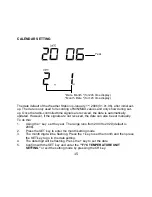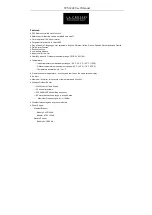
6
Note:
After the three sensors have been set up, user may need to check the readings displayed on
the Weather Station against those being shown on the sensor displays, in order to recognize
which channel each sensor is displayed.
If the signal reception is not successful on the first frequency (915MHz) for 45 seconds, the
frequency is changed to 920MHz and the learning is tried for another 45 seconds. If still not
successful the reception is tried for 45 seconds on 910MHz. This will also be done for re-
synchronization.
IMPORTANT:
Transmission problems will arise if the setting for additional sensors is not followed as
described above. Should transmission problems occur, it is necessary to remove the batteries
from all units and follow the set-up from step 1.
10.
Once the remote temperature has been received and displayed on the Weather Station,
the WWVB time code reception is automatically started. This takes typically between 3-
5 minutes in good conditions. (Depending on location, it may take up to four nights to
first receive the WWVB signal.)
11.
If after 10 minutes, the WWVB time has not been received, press the SET key to
manually enter a time initially.
Note:
Daily WWVB reception is attempted for a full hour between 12:00 am to 6:00 am. If the
reception is not successful, there will no further reception attempt until the following day. When
this is successful, the received time will override the manually set time. The date is also
updated with the received time. (Please refer also to notes on “
WWVB Radio controlled
Time
” and “
Manual Time Setting
”).







































